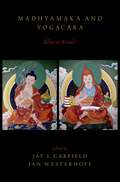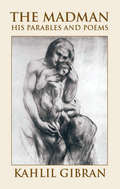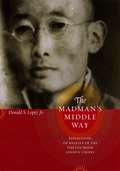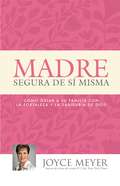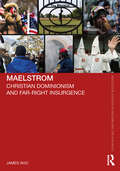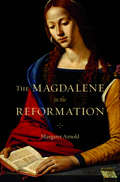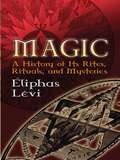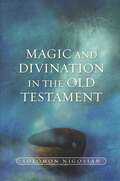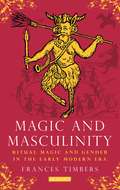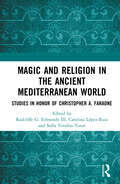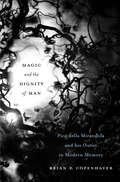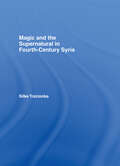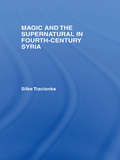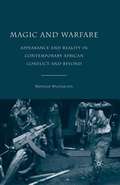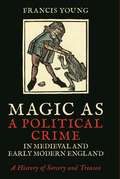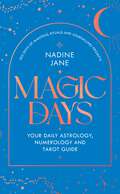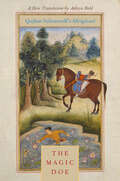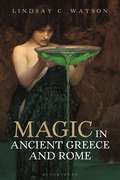- Table View
- List View
MADHYAMAKA & YOGACARA C: Allies or Rivals?
by Jay L. Garfield and Jan WesterhoffMadhyamaka and Yogacara are the two principal schools of Mahayana Buddhist philosophy. While Madhyamaka asserts the ultimate emptiness and conventional reality of all phenomena, Yogacara is usually considered to be idealistic. This collection of essays addresses the degree to which these philosophical approaches are consistent or complementary. Indian and Tibetan doxographies often take these two schools to be philosophical rivals. They are grounded in distinct bodies of sutra literature and adopt what appear to be very different positions regarding the analysis of emptiness and the status of mind. Madhyamaka-Yogacara polemics abound in Indian Buddhist literature, and Tibetan doxographies regard them as distinct systems. Nonetheless, scholars have tried to synthesize the two positions for centuries. This volume offers new essays by prominent experts on both these traditions, who address the question of the degree to which these philosophical approaches should be seen as rivals or as allies. In answering the question of whether Madhyamaka and Yogacara can be considered compatible, contributors engage with a broad range of canonical literature, and relate the texts to contemporary philosophical problems.
Madhyamaka and Yogacara: Allies or Rivals?
Madhyamaka and Yogacara are the two principal schools of Mahayana Buddhist philosophy. While Madhyamaka asserts the ultimate emptiness and conventional reality of all phenomena, Yogacara is usually considered to be idealistic. This collection of essays addresses the degree to which these philosophical approaches are consistent or complementary. Indian and Tibetan doxographies often take these two schools to be philosophical rivals. They are grounded in distinct bodies of sutra literature and adopt what appear to be very different positions regarding the analysis of emptiness and the status of mind. Madhyamaka-Yogacara polemics abound in Indian Buddhist literature, and Tibetan doxographies regard them as distinct systems. Nonetheless, scholars have tried to synthesize the two positions for centuries. This volume offers new essays by prominent experts on both these traditions, who address the question of the degree to which these philosophical approaches should be seen as rivals or as allies. In answering the question of whether Madhyamaka and Yogacara can be considered compatible, contributors engage with a broad range of canonical literature, and relate the texts to contemporary philosophical problems.
The Madman: His Parables and Poems
by Kahlil GibranWidely known in America as author of The Prophet, which sold more copies in the 20th century than any other book but the Bible, the great Lebanese-American poet and artist Kahlil Gibran (1883–1931) first became known to Americans in 1918 with the publication of The Madman.Thought-provoking and inspiring, the book is a collection of memorable, life-affirming parables and poems, many of them casting an ironic light on the beliefs, aspirations, and vanities of humankind — and many reminiscent of the work of Tagore and Nietzsche, both of whom were strong influences on Gibran.Among the 35 poems and parables in this volume are "How I Became a Madman," "The Two Hermits," "The Wise Dog," "The Good God and the Evil God," "Night and the Madman," "The Three Ants," "When My Sorrow Was Born," "And When My Joy Was Born," and many more.The book includes several illustrations by the author, whose exquisite drawings are reminiscent of Rodin and the best of Blake. ". . . the greatest of Arab Romantics and father of a 20th-century Romantic tradition whose impact on Arab writers has been at least as strong as that of 19th-century figures such as Wordsworth and Keats on their English-speaking counterparts." — Dr. Suheil Bushrui, Director of the Kahlil Gibran Chair on Values and Peace, University of Maryland
The Madman's Middle Way: Reflections on Reality of the Tibetan Monk Gendun Chopel (Buddhism and Modernity)
by Donald S. Lopez Jr.Gendun Chopel is considered the most important Tibetan intellectual of the twentieth century. His life spanned the two defining moments in modern Tibetan history: the entry into Lhasa by British troops in 1904 and by Chinese troops in 1951. Recognized as an incarnate lama while he was a child, Gendun Chopel excelled in the traditional monastic curriculum and went on to become expert in fields as diverse as philosophy, history, linguistics, geography, and tantric Buddhism. Near the end of his life, before he was persecuted and imprisoned by the government of the young Dalai Lama, he would dictate the Adornment for Nagarjuna’s Thought, a work on Madhyamaka, or “Middle Way,” philosophy. It sparked controversy immediately upon its publication and continues to do so today. The Madman’s Middle Way presents the first English translation of this major Tibetan Buddhist work, accompanied by an essay on Gendun Chopel’s life liberally interspersed with passages from his writings. Donald S. Lopez Jr. also provides a commentary that sheds light on the doctrinal context of the Adornment and summarizes its key arguments. Ultimately, Lopez examines the long-standing debate over whether Gendun Chopel in fact is the author of the Adornment; the heated critical response to the work by Tibetan monks of the Dalai Lama’s sect; and what the Adornment tells us about Tibetan Buddhism’s encounter with modernity. The result is an insightful glimpse into a provocative and enigmatic workthatwill be of great interest to anyone seriously interested in Buddhism or Asian religions.
The Madman's Middle Way: Reflections on Reality of the Tibetan Monk Gendun Chopel (Buddhism and Modernity)
by Donald S. Lopez Jr.Gendun Chopel is considered the most important Tibetan intellectual of the twentieth century. His life spanned the two defining moments in modern Tibetan history: the entry into Lhasa by British troops in 1904 and by Chinese troops in 1951. Recognized as an incarnate lama while he was a child, Gendun Chopel excelled in the traditional monastic curriculum and went on to become expert in fields as diverse as philosophy, history, linguistics, geography, and tantric Buddhism. Near the end of his life, before he was persecuted and imprisoned by the government of the young Dalai Lama, he would dictate the Adornment for Nagarjuna’s Thought, a work on Madhyamaka, or “Middle Way,” philosophy. It sparked controversy immediately upon its publication and continues to do so today. The Madman’s Middle Way presents the first English translation of this major Tibetan Buddhist work, accompanied by an essay on Gendun Chopel’s life liberally interspersed with passages from his writings. Donald S. Lopez Jr. also provides a commentary that sheds light on the doctrinal context of the Adornment and summarizes its key arguments. Ultimately, Lopez examines the long-standing debate over whether Gendun Chopel in fact is the author of the Adornment; the heated critical response to the work by Tibetan monks of the Dalai Lama’s sect; and what the Adornment tells us about Tibetan Buddhism’s encounter with modernity. The result is an insightful glimpse into a provocative and enigmatic workthatwill be of great interest to anyone seriously interested in Buddhism or Asian religions.
The Madman's Middle Way: Reflections on Reality of the Tibetan Monk Gendun Chopel (Buddhism and Modernity)
by Donald S. Lopez Jr.Gendun Chopel is considered the most important Tibetan intellectual of the twentieth century. His life spanned the two defining moments in modern Tibetan history: the entry into Lhasa by British troops in 1904 and by Chinese troops in 1951. Recognized as an incarnate lama while he was a child, Gendun Chopel excelled in the traditional monastic curriculum and went on to become expert in fields as diverse as philosophy, history, linguistics, geography, and tantric Buddhism. Near the end of his life, before he was persecuted and imprisoned by the government of the young Dalai Lama, he would dictate the Adornment for Nagarjuna’s Thought, a work on Madhyamaka, or “Middle Way,” philosophy. It sparked controversy immediately upon its publication and continues to do so today. The Madman’s Middle Way presents the first English translation of this major Tibetan Buddhist work, accompanied by an essay on Gendun Chopel’s life liberally interspersed with passages from his writings. Donald S. Lopez Jr. also provides a commentary that sheds light on the doctrinal context of the Adornment and summarizes its key arguments. Ultimately, Lopez examines the long-standing debate over whether Gendun Chopel in fact is the author of the Adornment; the heated critical response to the work by Tibetan monks of the Dalai Lama’s sect; and what the Adornment tells us about Tibetan Buddhism’s encounter with modernity. The result is an insightful glimpse into a provocative and enigmatic workthatwill be of great interest to anyone seriously interested in Buddhism or Asian religions.
Madre Segura de sí Misma: Como Guiar A Su Familia Con la Fortaleza y la Sabiduria de Dios
by Joyce MeyerEntrenadora, animadora, confidente, cocinera y chofer; la descripcion del trabajo de una madre es tan amplio como el horizonte. Tal vez es por eso que muchas madres luchan con la inseguridad y la incertidumbre, mientras hacen todo lo posible para criar a sus hijos en un mundo exigente y en constante cambio. Si alguna vez ha ido a la cama decepcionada consigo misma, si alguna vez ha sentido como si no diera la talla, o si alguna vez ha deseado que hubiera un manual sobre la maternidad, la autora de exitos de ventas #1 del New York Times, Joyce Meyer, tiene justamente el libro para usted.MADRE DE SI MISMA la animara y sabra que no esta sola; Dios esta con usted y quiere ayudarle con los desafios que enfrenta cada dia. A traves de historias inspiradoras, principios biblicos y las propias lecciones valiosas de la vida de Joyce, no hay duda de que va a descubrir el camino hacia una nueva confianza y alegria en la maternidad. No importa su edad, el tomano de su familia o las condiciones en que se encuentre, MADRE SEGURA DE SI MISMA le ayudara a ser esa madre alegre y confiada que Dios creo para que sea!
Madurai Meenatchi Ammai Pillai Tamizh
by KumarakurupararPillai Tamil or the "Tamil of Childhood" is one of the ninety-six forms of minor poetical compositions.In this literary compositon, Kumaraguruparar expresses his deep love for Tamil, as in his other works also, with apt descriptions and illustrations while delineating the characteristics of Goddess Meenakshi.
Maelstrom: Christian Dominionism and Far-Right Insurgence (Routledge Studies in Fascism and the Far Right)
by James AhoMaelstrom: Christian Dominionism and Far-Right Insurgence illuminates the latest outbreak of right-wing extremism in America. This book reviews the cyclical nature of right-wing resurgences in American history, dismisses the appropriateness of the word “fascism” to explain them, and then describes in depth the goal of “reconstructing” American institutions on the basis of biblical principles. It critiques the popular view that far-right politics is carried by stupid, socially isolated, nuts. To this end, it discusses the logicality of the “big lie” and examines in detail how people are recruited into the far-right, by entertaining the theories of authoritarianism and resource mobilization. Finally, it characterizes how the ends-oriented rationality of far-right activists differs from the mini-max criterion of rationality utilized by the ordinary person. This can motivate them to be violent and can frustrate efforts by the government to control them.
Maelstrom: Christian Dominionism and Far-Right Insurgence (Routledge Studies in Fascism and the Far Right)
by James AhoMaelstrom: Christian Dominionism and Far-Right Insurgence illuminates the latest outbreak of right-wing extremism in America. This book reviews the cyclical nature of right-wing resurgences in American history, dismisses the appropriateness of the word “fascism” to explain them, and then describes in depth the goal of “reconstructing” American institutions on the basis of biblical principles. It critiques the popular view that far-right politics is carried by stupid, socially isolated, nuts. To this end, it discusses the logicality of the “big lie” and examines in detail how people are recruited into the far-right, by entertaining the theories of authoritarianism and resource mobilization. Finally, it characterizes how the ends-oriented rationality of far-right activists differs from the mini-max criterion of rationality utilized by the ordinary person. This can motivate them to be violent and can frustrate efforts by the government to control them.
The Magdalene in the Reformation
by Margaret ArnoldProstitute, apostle, evangelist—the conversion of Mary Magdalene from sinner to saint is one of the Christianity’s most compelling stories. Less appreciated is the critical role the Magdalene played in remaking modern Christianity. Margaret Arnold shows that the Magdalene inspired devotees eager to find new ways to relate to God and the Church.
Maggie's Miracle: A Novel
by Karen KingsburyMegan Wright spent one unforgettable summer week with a boy when they were both teens. And despite a lifetime of heartache and bad choices, she has never let go of his magical definition of love, even if she has trouble believing in it. After college Megan settled for a relationship of convenience. Now she's a high powered attorney and, after the death of her husband two years ago, has been looking for help with her lonely young son. Across town, Casey Cummins is still dealing with the tragic loss of his wife. His search for meaning and hope leads him to contact the Manhattan Children's Organization, who connects him with a fatherless child. Life suddenly takes a series of unusual twists, and soon Megan will learn that the teenage boy from all those years ago actually kept his promise, and the miracle she prayed for as a girl is only a breath away.
Magic: A History of Its Rites, Rituals, and Mysteries
by A. E. Waite Éliphas Lévi"The most arresting, entertaining, and brilliant of all studies on the subject." — Arthur Edward WaiteA great work of literature as well as a pioneering classic of occultism, this voluminous historical survey traces the roots and manifestations of magic through the ages as a secret tradition persisting from remote times. Author Éliphas Lévi, pseudonym of Alphonse Louis Constant (1810-75), was a leader of the French occult revival, a spiritual teacher and magus who is today considered by some to be a founding father of the New Age movement. One of his most stunning (and original) revelations connects the Kabbalah with the Tarot, thus helping to inspire the ongoing fascination with the symbols of both, and their correspondences with each other. In this 1860 work, Lévi's discussions include topics that continue to intrigue modern readers, subjects as seemingly disparate as the mathematical magic of Pythagoras, magical monuments, magic and Christianity, the devil, the Knights Templar, alchemy, the illuminati, hallucinations, and many others that are equally alluring.The first part of the book explains the principles underlying magical operations, while the second part addresses the actual ritual and practice of transcendent magic. An essential resource for the library of anyone interested in mysticism and the occult sciences, this influential work appears here in its first English translation (from the original French) by the distinguished scholar and co-creator of the Rider-Waite Tarot deck, A. E. Waite.
Magic and Divination in the Old Testament
by Solomon NigosianHumans, since time immemorial, have tried to discover and influence the will of spirits and deities that they believed to be in charge of their lives. As a result, all cultures have produced certain special individuals thought to be closely in touch with the powers of the supernatural world. Was this true of ancient Israel? If so, who were the occult experts and what techniques were used by them? This study explores the many practices and rituals associated with magic and divination among the ancient Israelites as documented in the Old Testament. Seeking omens and consulting seers and diviners were widely practiced, though in the biblical text such activities are roundly condemned. Solomon Nigosian's scholarly work is written in language that makes it absorbing reading for both the biblical scholar and the layperson.
Magic and Masculinity: Ritual Magic and Gender in the Early Modern Era (International Library Of Historical Studies)
by Frances TimbersIn early modern England, the practice of ritual or ceremonial magic – the attempted communication with angels and demons – both reinforced and subverted existing concepts of gender. The majority of male magicians acted from a position of control and command commensurate with their social position in a patriarchal society; other men, however, used the notion of magic to subvert gender ideals while still aiming to attain hegemony. Whilst women who claimed to perform magic were usually more submissive in their attempted dealings with the spirit world, some female practitioners employed magic to undermine the patriarchal culture and further their own agenda. Frances Timbers studies the practice of ritual magic in the sixteenth and seventeenth centuries focusing especially on gender and sexual perspectives. Using the examples of well-known individuals who set themselves up as magicians (including John Dee, Simon Forman and William Lilly), as well as unpublished diaries and journals, literature and legal records, this book provides a unique analysis of early modern ceremonial magic from a gender perspective.
Magic and Religion in the Ancient Mediterranean World: Studies in Honor of Christopher A. Faraone
by Radcliffe G. Edmonds III Carolina López-Ruiz Sofía Torallas-TovarThis volume explores aspects of ancient magic and religion in the ancient Mediterranean, specifically ways in which religious and mythical ideas, including the knowledge and practice of magic, were transmitted and adapted through time and across Greco-Roman, Near Eastern, and Egyptian cultures. Offering an original and innovative combination of case studies on the material aspects and cross-cultural transfers of magic and religion, this book brings together a range of contributions that cross and connect sub-fields with a pan-Mediterranean, comparative scope. Section I investigates the material aspects of magical practices, including first editions and original studies on papyri, gems, lamellae containing binding curses and protective texts, and other textual media in ancient book culture. Several chapters feature the Greco-Egyptian Magical Papyri, the compilation of magical recipes in the formularies, and the role of physical book-forms in the transmission of magical knowledge. Section II explores magic and religion as nodes of cultural exchange in the ancient Mediterranean. Case studies range from Egypt to Anatolia and from Syria-Phoenicia to Sicily, with Greco-Roman religion and myth integrated in a diverse and interconnected Mediterranean landscape. Readers encounter studies featuring charismatic figures of Magi and itinerant begging priests, the multiple understandings of deities such as Hekate, Herakles, or Aphrodite, or the perceived exotic origin of cult statues, mummies, amulets, and cursing formulae, which bring to light the rich intercultural networks of the ancient Mediterranean, and the crucial role of magic and religion in the process of cross-cultural adaptation and innovation. Magic and Religion in the Ancient Mediterranean World appeals to both specialized and non-specialized audiences, with expert contributions written in an accessible way. This is a fascinating resource for students and scholars working on magic, religion, and mythology in the ancient Mediterranean.
Magic and Religion in the Ancient Mediterranean World: Studies in Honor of Christopher A. Faraone
by Radcliffe G. Edmonds Carolina López-Ruiz Sofía Torallas TovarThis volume explores aspects of ancient magic and religion in the ancient Mediterranean, specifically ways in which religious and mythical ideas, including the knowledge and practice of magic, were transmitted and adapted through time and across Greco-Roman, Near Eastern, and Egyptian cultures. Offering an original and innovative combination of case studies on the material aspects and cross-cultural transfers of magic and religion, this book brings together a range of contributions that cross and connect sub-fields with a pan-Mediterranean, comparative scope. Section I investigates the material aspects of magical practices, including first editions and original studies on papyri, gems, lamellae containing binding curses and protective texts, and other textual media in ancient book culture. Several chapters feature the Greco-Egyptian Magical Papyri, the compilation of magical recipes in the formularies, and the role of physical book-forms in the transmission of magical knowledge. Section II explores magic and religion as nodes of cultural exchange in the ancient Mediterranean. Case studies range from Egypt to Anatolia and from Syria-Phoenicia to Sicily, with Greco-Roman religion and myth integrated in a diverse and interconnected Mediterranean landscape. Readers encounter studies featuring charismatic figures of Magi and itinerant begging priests, the multiple understandings of deities such as Hekate, Herakles, or Aphrodite, or the perceived exotic origin of cult statues, mummies, amulets, and cursing formulae, which bring to light the rich intercultural networks of the ancient Mediterranean, and the crucial role of magic and religion in the process of cross-cultural adaptation and innovation. Magic and Religion in the Ancient Mediterranean World appeals to both specialized and non-specialized audiences, with expert contributions written in an accessible way. This is a fascinating resource for students and scholars working on magic, religion, and mythology in the ancient Mediterranean.
Magic and the Dignity of Man: Pico della Mirandola and His <i>Oration</i> in Modern Memory
by Brian P. CopenhaverPico della Mirandola, one of the most remarkable thinkers of the Renaissance, has become known as a founder of humanism and a supporter of secular rationality. Brian Copenhaver upends this understanding of Pico, unearthing the magic and mysticism in the most famous work attributed to him, The Oration on the Dignity of Man.
Magic and the Supernatural in Fourth Century Syria
by Silke TrzcionkaMagic and the Supernatural in Fourth Century Syria presents an in-depth investigation of a variety of ‘magical’ practices with a focused study in the late antique Syria and Palestine. Offering new research using both archaeological and literary sources, and blending Classical, Jewish, and Christian traditions from both regions, Silke Trzcionka examines a myriad of magical activities such as: curses, spells and amulets accusations related to chariot races, love and livelihood methods involved in protection, healing, possession and exorcism. The information is provided with clarity and theoretical sophistication which enables students to develop an understanding of these beliefs and their place within the social context of the time. Altogether, a useful, enlightening and enjoyable book which students studying religion and/or social history will find invaluable.
Magic and the Supernatural in Fourth Century Syria
by Silke TrzcionkaMagic and the Supernatural in Fourth Century Syria presents an in-depth investigation of a variety of ‘magical’ practices with a focused study in the late antique Syria and Palestine. Offering new research using both archaeological and literary sources, and blending Classical, Jewish, and Christian traditions from both regions, Silke Trzcionka examines a myriad of magical activities such as: curses, spells and amulets accusations related to chariot races, love and livelihood methods involved in protection, healing, possession and exorcism. The information is provided with clarity and theoretical sophistication which enables students to develop an understanding of these beliefs and their place within the social context of the time. Altogether, a useful, enlightening and enjoyable book which students studying religion and/or social history will find invaluable.
Magic and Warfare: Appearance and Reality in Contemporary African Conflict and Beyond
by N. WlodarczykThis study explores the roles played by magic in contemporary African warfare, specifically through the case of Sierra Leone, to assess its impact on behaviour in conflict. A conceptual framework is suggested for analysing culturally alien practices more broadly and to inform approaches to civilian and military intervention.
Magic as a Political Crime in Medieval and Early Modern England: A History of Sorcery and Treason (International Library of Historical Studies)
by Francis YoungTreason and magic were first linked together during the reign of Edward II. Theories of occult conspiracy then regularly led to major political scandals, such as the trial of Eleanor Cobham Duchess of Gloucester in 1441. While accusations of magical treason against high-ranking figures were indeed a staple of late medieval English power politics, they acquired new significance at the Reformation when the 'superstition' embodied by magic came to be associated with proscribed Catholic belief. Francis Young here offers the first concerted historical analysis of allegations of the use of magic either to harm or kill the monarch, or else manipulate the course of political events in England, between the fourteenth century and the dawn of the Enlightenment. His book addresses a subject usually either passed over or elided with witchcraft: a quite different historical phenomenon. He argues that while charges of treasonable magic certainly were used to destroy reputations or to ensure the convictions of undesirables, magic was also perceived as a genuine threat by English governments into the Civil War era and beyond.
Magic Days: Unlock your daily magic with the power of astrology, rituals and journalling for spiritual self-care
by Nadine JaneRead one page a day to transform your life.What if self-care, self-empowerment and self-understanding started with a single page? Astrology, numerology, and tarot are rituals with ancient roots that are observed around the world for their ability to help us reconnect with your inner self and feel the magic around - and within - ourselves. With many practices to draw from, astrology guru Nadine Jane has combined the essence of the most popular forms of divination in one single volume.Magic Days is your go-to 'spiritual almanac'. It guides each star sign through the astrological year and offers insight into how the stars are shaping your destiny. Each page is laid out with everything you need to know and includes mantras, rituals and journal prompts to help you reflect on the day's wisdom and channel the energy you need to thrive.The book charts your year and offers guidance on what your relationships and spiritual journey have in store. Whether you're dipping your toes into spiritual waters for the first time, are a devoted reader of your daily horoscope or just secretly wants to know what the future may have in store for you, Magic Days is the perfect guide to year-round spiritual wellbeing.
The Magic Doe: Qutban Suhravardi's Mirigavati
by Aditya Behl Wendy DonigerMirigavati or The Magic Doe is the work of Shaikh Qutban Suhravardi, an Indian Sufi master who was also an expert poet and storyteller attached to the glittering court-in-exile of Sultan Husain Shah Sharqi of Jaunpur. Composed in 1503 as an introduction to mystical practice for disciples, this powerful Hindavi or early Hindi Sufi romance is a richly layered and sophisticated text, simultaneously a spiritual enigma and an exciting love story full of adventures. The Mirigavati is both an excellent introduction to Sufism and one of the true literary classics of pre-modern India, a story that draws freely on the large pool of Indian, Islamic, and European narrative motifs in its distinctive telling of a mystical quest and its resolution. Adventures from the Odyssey and the voyages of Sindbad the Sailor--sea voyages, encounters with monstrous serpents, damsels in distress, flying demons and cannibals in caves, among others--surface in Suhravardi 's rollicking tale, marking it as first-rate entertainment for its time and, in private sessions in Sufi shrines, a narrative that shaped the interior journey for novices. Before his untimely death in 2009, Aditya Behl had finished this complete blank verse translation of the critical edition of the Mirigavati, an epic romance that is also the symbolic key to a secret Sufi mystical tradition and a gem of Indian and world literature.
Magic in Ancient Greece and Rome
by Lindsay C. WatsonParting company with the trend in recent scholarship to treat the subject in abstract, highly theoretical terms, Magic in Ancient Greece and Rome proposes that the magic-working of antiquity was in reality a highly pragmatic business, with very clearly formulated aims - often of an exceedingly maligant kind. In seven chapters, each addressed to an important arm of Greco-Roman magic, the volume discusses the history of the rediscovery and publication of the so-called Greek Magical Papyri, a key source for our understanding of ancient magic; the startling violence of ancient erotic spells and the use of these by women as well as men; the alteration in the landscape of defixio (curse tablet) studies by major new finds and the confirmation these provide that the frequently lethal intent of such tablets must not be downplayed; the use of herbs in magic, considered from numerous perspectives but with an especial focus on the bizarre-seeming rituals and protocols attendant upon their collection; the employment of animals in magic, the factors determining the choice of animal, the uses to which they were put, and the procuring and storage of animal parts, conceivably in a sorcerer's workshop; the witch as a literary construct, the clear homologies between the magical procedures of fictional witches and those documented for real spells, the gendering of the witch-figure and the reductive presentation of sorceresses as old, risible and ineffectual; the issue of whether ancient magicians practised human sacrifice and the illuminating parallels between such accusations and late 20th century accounts of child-murder in the context of perverted Satanic rituals.By challenging a number of orthodoxies and opening up some underexamined aspects of the subject, this wide-ranging study stakes out important new territory in the field of magical studies.
